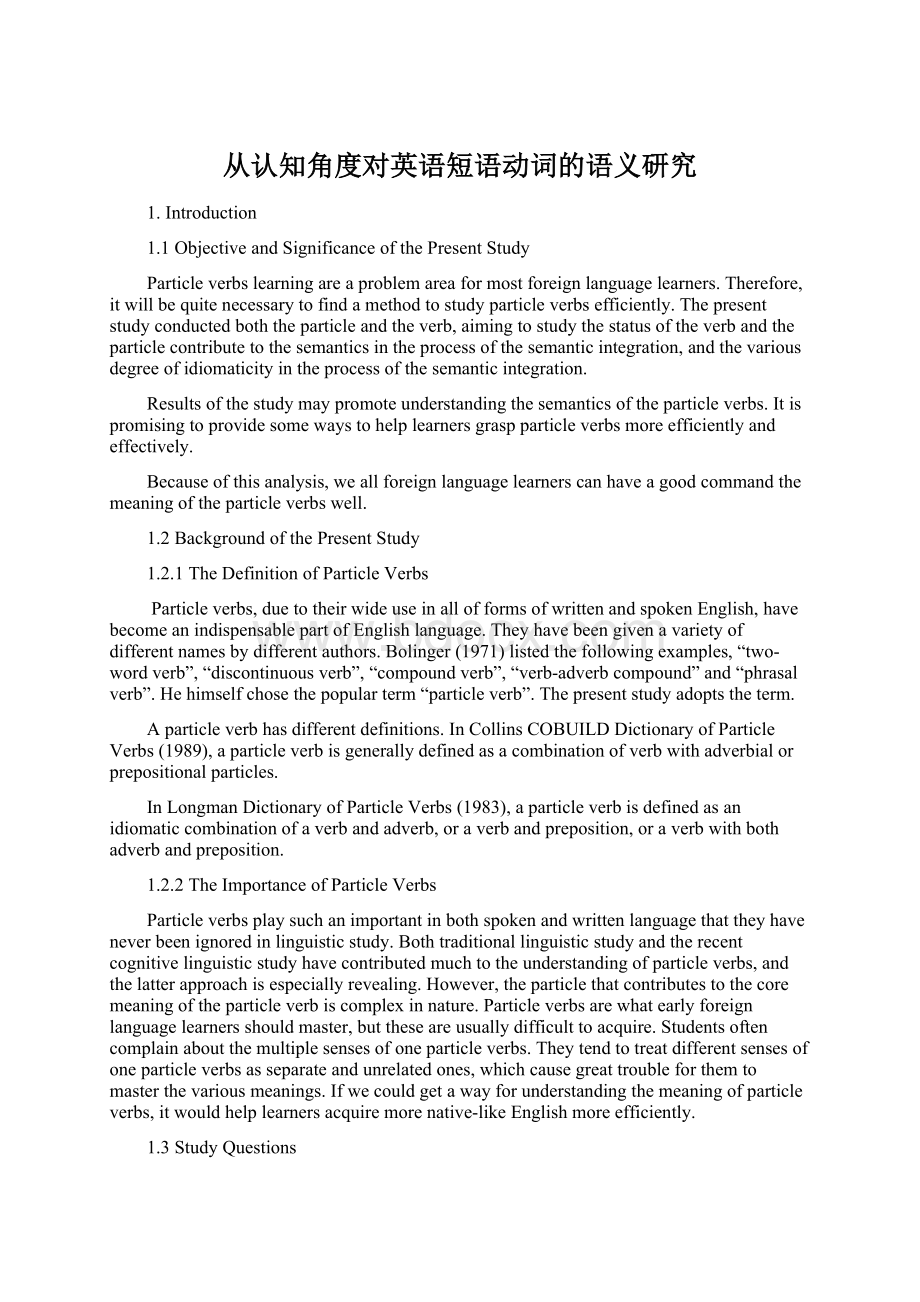从认知角度对英语短语动词的语义研究文档格式.docx
《从认知角度对英语短语动词的语义研究文档格式.docx》由会员分享,可在线阅读,更多相关《从认知角度对英语短语动词的语义研究文档格式.docx(9页珍藏版)》请在冰豆网上搜索。

Becauseofthisanalysis,weallforeignlanguagelearnerscanhaveagoodcommandthemeaningoftheparticleverbswell.
1.2BackgroundofthePresentStudy
1.2.1TheDefinitionofParticleVerbs
Particleverbs,duetotheirwideuseinallofformsofwrittenandspokenEnglish,havebecomeanindispensablepartofEnglishlanguage.Theyhavebeengivenavarietyofdifferentnamesbydifferentauthors.Bolinger(1971)listedthefollowingexamples,“two-wordverb”,“discontinuousverb”,“compoundverb”,“verb-adverbcompound”and“phrasalverb”.Hehimselfchosethepopularterm“particleverb”.Thepresentstudyadoptstheterm.
Aparticleverbhasdifferentdefinitions.InCollinsCOBUILDDictionaryofParticleVerbs(1989),aparticleverbisgenerallydefinedasacombinationofverbwithadverbialorprepositionalparticles.
InLongmanDictionaryofParticleVerbs(1983),aparticleverbisdefinedasanidiomaticcombinationofaverbandadverb,oraverbandpreposition,oraverbwithbothadverbandpreposition.
1.2.2TheImportanceofParticleVerbs
Particleverbsplaysuchanimportantinbothspokenandwrittenlanguagethattheyhaveneverbeenignoredinlinguisticstudy.Bothtraditionallinguisticstudyandtherecentcognitivelinguisticstudyhavecontributedmuchtotheunderstandingofparticleverbs,andthelatterapproachisespeciallyrevealing.However,theparticlethatcontributestothecoremeaningoftheparticleverbiscomplexinnature.Particleverbsarewhatearlyforeignlanguagelearnersshouldmaster,buttheseareusuallydifficulttoacquire.Studentsoftencomplainaboutthemultiplesensesofoneparticleverbs.Theytendtotreatdifferentsensesofoneparticleverbsasseparateandunrelatedones,whichcausegreattroubleforthemtomasterthevariousmeanings.Ifwecouldgetawayforunderstandingthemeaningofparticleverbs,itwouldhelplearnersacquiremorenative-likeEnglishmoreefficiently.
1.3StudyQuestions
Weallknowthatthemeaningoftheparticleverbsaredifficulttoacquire,whichcausegreattroubleformanyforeignlanguagelearnerstomasterthevariousmeanings.Numerousstudieshavebeenconductedonparticleverbsintermsofcompositionality,idiomaticandparticleposition.Traditionalstudieswereconductedfromthestructuralismperspective,anditfocusesmoreontheformsratherthanthemeaningsofparticleverbs.Therecentcognitivestudy,especiallythemetaphoricalapproach,achievesmoresuccessinunderstandingtheprocessofsemanticformationofparticleverbs.Theyconcludedthattheparticlesandtheverbcontributedtomoreorlessidiomaticmeaningoftheparticleverbs.Althoughthesestudieshavecontributedmoretotheparticleverbs,atleast,thereisalsoaproblemthattheyhavenotmentioned.Sothisthesismainlyfocusesonthefollowingquestions:
1)Howaboutthestatusoftheverbandtheparticlecontributetothesemanticsintheprocessofthesemanticintegration?
2)Howaboutthevariousdegreeofidiomaticityintheprocessofthesemanticintegration?
2.EarlyStudiesonParticleVerb
NumerousstudieshavebeenconductedonparticleVerbswithadesireforsomesemanticaccountofthesemanticsofparticleverbs,atleastintermsofcompositionality,toattempttheinterfacebetweencompositionalityandparticleposition.
2.1TraditionalStudy
Mosttraditionalstudiesonparticleverbsareconductedfromthestructuralismperspective,andthestudyonthisissuecanbeseenastherepresentative(Quirk1985:
1151-1168).
Quirketalfirstclassifytheparticleintothreegroups:
(A)prepositionsonly:
e.g.‘against’‘at’,‘for’,etc.(B)Eitherprepositionorspatialadverbs:
e.g.‘about’‘by’,‘over’,etc.(C)Spatialadverbsonly:
e.g.‘ahead’,‘away’,‘back’,etc.Theclassificationaremadeaccordingtotheirgrammaticalcharacteristics:
Group(A)requireafollowingnounphraseasaprepositionalcomplement;
Group(C)donotrequiresuchcomplement;
andingroup(B)bothconstructionsareacceptable.(Quirk1985:
1151)
2.2RecentMetaphoricalApproach
Sincetraditionalstudiespaylittleattentiontothemeaningofparticleverbs,theseexplanationscannottotallyexplainthenatureofthem.Asamatteroffact,alltheirsyntacticfeaturesaredeterminedbythesemanticsofthecomponentsofparticleverbs,ratherthanstandbythemselves.Therefore,thereisastrongneedforanotherapproachtoattempttheglobalmeaningandthesyntacticbehaviorofparticleverbs.Thisistheapproachtakenbymostrecentstudiesfromtheperspectiveofcognitivelinguistics.
Hedealswithmetaphorisationintheformationofaverb-particlestructure.Whentheverb-particleconstruction‘tofaceupto’isformed,theverb‘toface’isalreadyafigurativeverb.Suchasapartofaperson,thefacemetonymicallystandsforthewholeperson.Moreover,thereisadoubleextensionfrom‘toface’into‘tofaceto’(Hampe2000:
81—101).
Hampe’sanalysisconvincinglyshowsthatthat‘tofaceproblems’isnotsimplysynonymouswith‘tofaceuptoproblems’.
1)a.Wefacedseriousproblems.
b.Seriousproblemsfacedus.
2)a.Wearefacinguptoahugeproblem.
b.Ahugeproblemisfacinguptous.
Hampeclaimsthattheparticle‘up’in‘tofaceupto’ismotivatedbyconceptualmetaphorsinmultiplewaysandshemakesanimportantgeneralization:
“Thissimultaneousmotivationbymorethanoneconceptualmetaphorisaverycommonpropertyparticleinaverb-particleconstruction.”Theelement‘face’in‘tofaceto’has,asthesimpleverb‘toface’,thesense“ofbeingsituatedinfrontoforoppositesomeentity”.Thislocationsensealsoexplainswhythesimpleverb‘toface’allowsbothhumanandnon-humansubjects.Thetwocomponents‘up’and‘to’,addrichextensionpossibility.Theparticle‘up’evokesthestraightorup-downorientationandofthissourcedomainitis“theupperlimitoftheverticalityorientation”thatisaddedtotheeventstructureoftoface.Thisphysicalspacedomainformanydifferentmetaphorisationallsuggestingpositivevalues.Thepreposition‘to’thatsignsaphysicallocationinthespace.Asaconceptualmetaphor,‘to’implies“motiontowardsanabstractentity”suchasaproblem,adifficulty,etc.Eachofthesethreemetaphorsystemscontributestothecompositionalglobalmeaningof‘tofaceupto’as“toactivelyconfrontanentitythatpresentsaproblem,adifficultyforone’sfurtheractions”.However,thephysicalmeaningof‘tofaceupto’surpassesthiscompositionalstructure,sinceitalsocontainsthenotionofan“energetichumanagent”andthatof“emotionality”.Inthissensetheconstructionisstronglyidiomatic.
Themetaphoricapproachfollowingthepathofcognitivelinguisticsseemstobedeeperintotheprocessofsemanticformationofparticleverbs.Dependingonthisapproach,itisthemetaphoricextensioninboththeverbandtheparticle,whichplayaroleinidiomaticmeaningoftheparticleverb.Weagreewiththisunderstanding.However,thesemetaphoricalstudieshavenotgivenusafullpictureofthiscombinationprocess.Forexample,theydonotexplainclearlyandsatisfactorilyhowandinwhatwaystheintegrationisachievedontheconceptuallevelinourmind,andhowwecanaccountforthecombinatoryabilitybetweenthetwocomponents.
3.RelevantTheoreticalBackground
Wewillpresentthemaintheoriesandprinciplesthathaveguidedourunderstandingandanalysisofparticleverbs,particularlyparticleverbswith‘at’.
3.1GeneralConceptofCognitiveSemantics
ThreetenetsofcognitivesemanticscomparingwithGrandenfors’s‘realistic’viewasthefollowing(1998:
21-25):
-Meaningisconceptualizationinacognitivemodel.
-Semanticsisprimarytosyntaxandpartlydeterminesit.
-Conceptsshowprototypeeffects.
Thesetenetsmarkthedifferencebetweencognitiveapproachandothertraditionalapproachesandprovidenewinsightsintolanguagestudy.Withincognitivelinguistics,linguisticscognitionsimplyiscognitionanditisaninextricablephenomenonofoverallhumancognition,andsemanticsistheprimarycomponent.Allthevariousphenomenaoflanguageareinterwovenwitheachotheraswellaswithallofcognitionbecausetheyareallmotivatedbythesameforce:
thedrivetomakesenseofourworld.Meaningisthereforenottidilycontainedinthelexicon,butrangesallthroughthelinguisticspectrum,becausemeaningistheveryenergythatpropelsthemotoroflanguage.Grammarisabstractmeaningstructurethatinteractswiththemoreconcretemeaningoflexicon;
Grammarandlexiconarenottwodiscretetypesofmeaning.Therefore,meaningbearsthecentralstatusinalanguagesystem.
Giventhecentreroleofmeaninginlanguage,itisessentialthatweunderstandwhatitisandwhereitcomesfrom.Cognitivelinguisticsworksfromthepremisethatmeaningisembodied(Lakoff:
1987).Thismeansthatmeaningisgroundedinthesharedhumanexperienceofbodilyexistence,anditisbasedonconventionalizedconceptualstructures(Saeed:
2000).
Sincehumanb